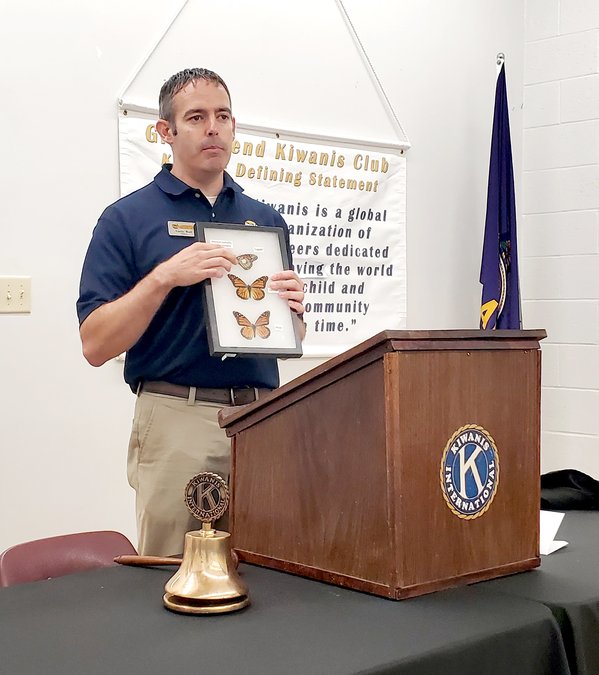With no water to speak of at the Cheyenne Bottoms Wildlife Refuge, there is also “very little to no bird activity,” according to Curtis Wolf, executive director at the Kansas Wetlands Education Center.
“Obviously the big question is, are any birds going to stop? The answer to that is, really, no,” he said, speaking to the Great Bend Kiwanis Club earlier this month.
“No waterfowl or shorebirds; they are obviously not going to stop because there are no resources for them. Birds are still coming through but they’re not stopping here.”
Wolf said he was reminded that the last time the Bottoms was totally dry, in 2012, whooping cranes passed over Barton County and stopped at Wilson Lake.
In 2007 there was flooding and then in 2011 the Bottoms started to dry up, being totally dry by 2012. Then around Labor Day of 2013 there was a 6-inch rain that filled the pools and broke the drought.
“It’s interesting looking at how those things cycle, going from that huge flood in 2007 to four or five years later being bone dry, and maintaining for a while and now this drought again. It happens. There’s no doubt we might be seeing this more frequently but who knows?”
Jason Wagner, wildlife manager at the Cheyenne Bottoms Wildlife Refuge, posted a message about drought conditions on his answering machine back on Oct. 7 – just before the opening of regular duck season for this zone – and as of Friday he said there was no need to update it. The message: Cheyenne Bottoms is 100% dry, with no water in the hunting pools.
Duck season runs until the first Sunday in January, so there’s still time for a good rain to turn things around, Wagner said Friday. But this Cheyenne Bottoms waterfowl report from Oct. 4 is still valid:
Absolutely no water, therefore no waterfowl
Do not expect the report to be updated until conditions change. If the report has not been updated in a few days, please assume that conditions and bird numbers are the same as the last update.
The good news
“It’s not all bad,” Wagner said. “We get as much work done as we possibly can in dry years. We’re able to do things that we have not been able to do since 2012 or 2013,” such as rebuilding islands in the pools.
Wagner is concentrating on habitat improvements, and controlling the cattails and the Phragmites, an invasive plant that spreads quickly and has little wildlife value, out-competing many of the good wetland plants.
“Right now, they’re doing a lot of disking, trying to disk up those cattails,” Wolf said. “When they get to patches of Phragmites, they don’t want to disk that up because that really just spreads it.” Instead, they contracted with the Co-op to do some spraying.
A $6 million renovation project funded by a grant from the Kansas Department of Wildlife and Parks for infrastructure improvements is about done. This includes a new pump that they’ve installed at the end of the inlet canal.
Surface rights only
“When it’s dry, a lot of the hunters ask, ‘Why aren’t they just pumping the water?’” Wolf said. “The state does not have groundwater rights. They cannot pump water out of the ground to fill up any of the basins.”
The Bottoms does have surface water rights and can divert water off of the Ark River and Wet Walnut. “But if you go down to the Diversion Dam, the water is far from it,” Wolf said.
“The gates are open and ready for rainfall,” Wagner agreed.
Other activity
Birdwatchers will be fairly disappointed this fall in what they might see at the wetlands, Wolf said. “I do think we will start seeing some cranes pass through, whether they stop or not. They might; they’re not as obligate of the wetland area, they’re going to use the crop fields and wheat fields. So I think that we’ll see some cranes around the area probably starting here (this week).”
Also, he doesn’t expect to see big groups of geese at the Bottoms this year but said they may choose to stop at Veterans Lake in Great Bend instead.
One thing that has become popular with the dry pools is for people to hunt for World War II artifacts. The Kansas Wetlands Education Center even took people on a tour for that purpose recently.
“The Bottoms was used in the 1940s as a practice bombing range and gunnery range. You can still find those 50-caliber shell casings all over out there. We had a great crowd for that program and everyone found shell casings and other stuff, which was pretty cool. We’ve noticed a lot of people are out there walking around in the pools and that’s totally legal.”
However, there are areas of the refuge that are closed to human activities year-round, and those restrictions still apply. The restricted ares are clearly marked, Wagner said.








